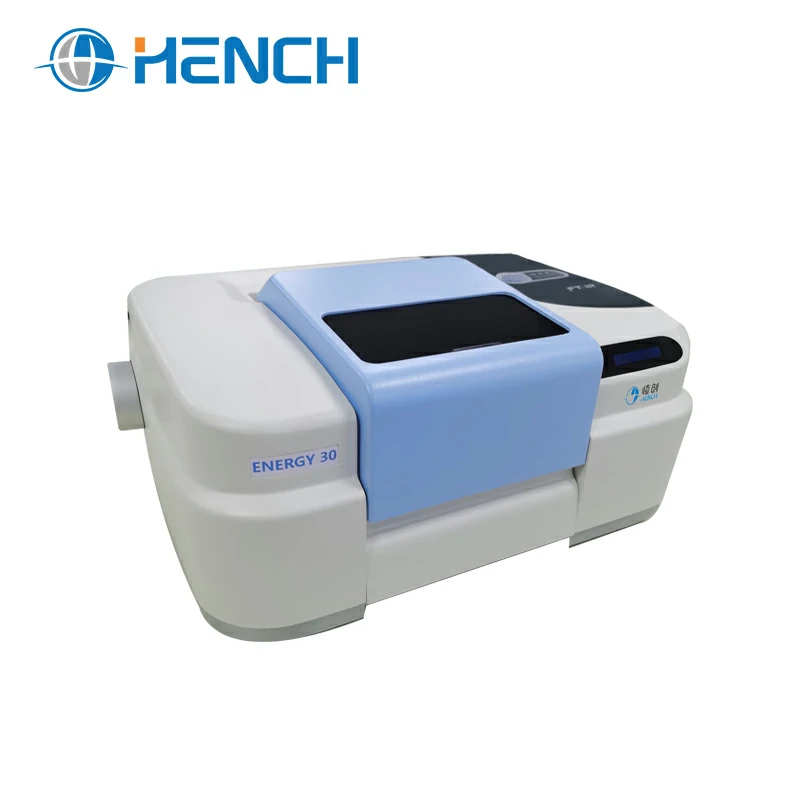Что такое инфракрасный спектрометр?
Инфракрасный спектрометр измеряет, как образец поглощает инфракрасный свет.. Разные молекулы поглощают свет на разных частотах, создание уникального спектрального отпечатка. This pattern helps identify unknown materials and analyze chemical structures.
А Fourier transform infrared spectrometer (FTIR) uses mathematical algorithms to convert raw light data into readable spectra. It captures a broad range of wavelengths simultaneously, offering faster and more precise results compared to older dispersive systems.
Key Components of an Infrared Spectrometer
| Component | Function | Описание |
|---|---|---|
| IR Source | Emits infrared radiation | Provides energy to interact with the sample |
| Interferometer | Modulates light waves | Converts light into an interference pattern |
| Sample Compartment | Holds the sample | Allows transmission or reflection measurement |
| Detector | Records light intensity | Measures how much light passes through or reflects |
| Computer System | Processes data | Converts signals into spectra for analysis |
Understanding the Principle of FTIR
The Fourier transform infrared spectrometer works on the principle of interference. Light from the source passes through an interferometer that splits and recombines the beam. When this light interacts with the sample, some wavelengths are absorbed while others are transmitted.
The detector records the resulting signal, known as an interferogram. A Fourier transform algorithm then converts this data into a spectrum showing absorption peaks corresponding to molecular vibrations. These peaks reveal the sample’s chemical composition and structure.
Preparing the Instrument
Прежде чем начать, ensure the instrument is clean and properly calibrated. Dust or residue can distort results. Power on the FTIR and allow it to stabilize. Set the background scan to eliminate environmental interference.
Use clean tools when handling samples. Even small contaminants can create false peaks in the spectrum. For solid samples, ensure they are finely ground. For liquids, use a liquid cell with infrared-transparent windows.

Sample Preparation Methods
| Sample Type | Preparation Technique | Common Material |
|---|---|---|
| Solid | Pressed pellet or ATR mode | KBr pellet |
| Liquid | Liquid cell or ATR mode | NaCl cell |
| Gas | Gas cell with path length control | IR-transparent cell |
Step-by-Step Guide to Using an Infrared Spectrometer
- Start the Instrument – Power on the Fourier transform infrared spectrometer and allow it to warm up for a few minutes.
- Run Background Scan – Perform a background scan to capture environmental interference.
- Prepare the Sample – Select the appropriate method for your sample type.
- Place the Sample – Insert the sample into the holder, ensuring it is centered and secure.
- Set Parameters – Choose the resolution, scan number, and measurement mode.
- Run the Scan – Start the measurement and wait until data collection is complete.
- Analyze the Spectrum – Observe peaks and compare them to reference spectra.
- Save and Document – Record your results for future reference or reporting.
Using the ATR Accessory
The Attenuated Total Reflection (ATR) accessory simplifies FTIR analysis. It allows direct measurement of solids, liquids, or gels without complex preparation. Place the sample on the crystal surface, tighten the pressure clamp, and start scanning.
The ATR technique is widely used in the pharmaceutical and polymer industries because it requires minimal material and provides fast, accurate results.
Analyzing the Spectrum
The resulting spectrum displays transmittance or absorbance versus wavenumber. Each peak represents a molecular vibration. Например, a broad band around 3400 cm⁻¹ indicates O–H stretching, while peaks near 1700 cm⁻¹ suggest carbonyl groups.
Accurate interpretation requires understanding functional group frequencies. Comparing your spectrum with a standard library helps confirm the material identity.
Common Infrared Absorption Bands
| Functional Group | Typical Range (cm⁻¹) | Example |
|---|---|---|
| O–H Stretch | 3200–3600 | Alcohols, вода |
| C=O Stretch | 1650–1750 | Ketones, esters |
| C–H Stretch | 2850–3000 | Hydrocarbons |
| N–H Bend | 1500–1600 | Amines |
| C–O Stretch | 1000–1300 | Ethers, esters |
Maintenance and Calibration
Regular maintenance ensures long-term accuracy of your Fourier transform infrared spectrometer. Keep the optical path clean and check desiccants to prevent moisture absorption. Calibrate the instrument periodically using reference materials.
Software updates and detector sensitivity checks are also essential. A stable baseline and clear peaks indicate that calibration is correct.
Распространенные ошибки и как их избежать
- Skipping the background scan leads to poor data quality.
- Using dirty sample holders introduces unwanted peaks.
- Overlapping peaks can occur from incorrect sample concentration.
- Ignoring environmental control may cause baseline drift.
By following best practices and verifying results, users ensure reliable outcomes every time.
Applications of Infrared Spectrometers
Infrared spectrometers are used in various fields:
- Chemical analysis – Identifying unknown compounds and mixtures.
- Pharmaceutical testing – Confirming purity and composition of drugs.
- Material science – Studying polymers, coatings, and composites.
- Environmental monitoring – Detecting pollutants in air or water.
- Food quality control – Measuring moisture, fat, and protein content.
Each application benefits from the precision and speed of a Fourier transform infrared spectrometer.
Safety Precautions When Using the Instrument
Always handle infrared spectrometers with care. Avoid touching optical components with bare hands. Keep liquids away from electrical parts. Operate the instrument in a controlled environment free from vibration and dust.
Wear protective gloves and goggles when handling chemicals. Follow your laboratory’s safety guidelines to minimize risks.
Advantages of Using FTIR Technology
The Fourier transform infrared spectrometer offers multiple advantages:
- Rapid data collection across all wavelengths.
- High signal-to-noise ratio for better clarity.
- Minimal sample preparation.
- Capability to analyze solids, liquids, and gases.
- Non-destructive testing, preserving the sample.
These benefits make FTIR the preferred choice for research and industrial analysis.
Troubleshooting Common Issues
If spectra appear distorted, check for alignment issues or contamination. Weak signals may indicate low sample concentration or detector malfunction. Baseline drift often results from humidity or temperature changes.
Recalibration and re-scanning typically resolve most issues. Consistent cleaning and maintenance prevent major problems.
Future Trends in Infrared Spectroscopy
The future of infrared spectroscopy lies in miniaturization and automation. Portable FTIR devices now allow on-site analysis in industries and field research. Advanced software with AI algorithms improves data interpretation and pattern recognition.
Integration with cloud databases enables global data sharing and faster research collaboration. These innovations continue to expand the power and accessibility of infrared spectroscopy.
Заключение
Learning how to use an infrared spectrometer is essential for accurate chemical analysis. The Fourier transform infrared spectrometer combines speed, precision, and versatility to deliver reliable results across industries. By mastering sample preparation, scanning, and data interpretation, users can confidently identify materials and monitor processes.
